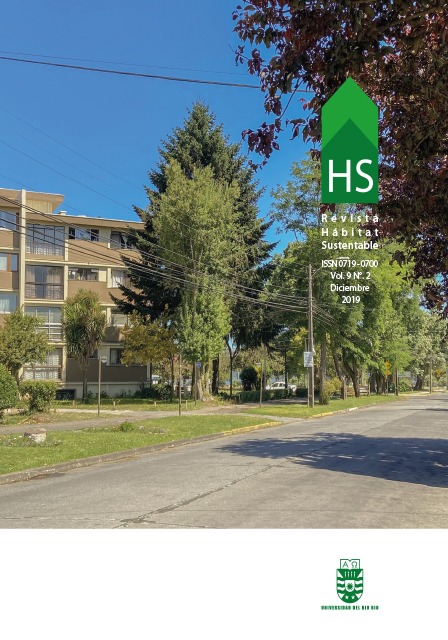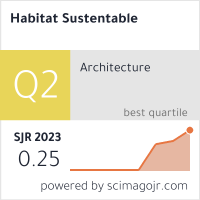Metodología para elaborar una cartografía regional y aplicar estrategias bioclimáticas según la Carta de Givoni
DOI:
https://doi.org/10.22320/07190700.2019.09.02.05Palabras clave:
arquitectura bioclimática, cartografía, climatología, territorioResumen
Se plantea como objetivo de la investigación expuesta la viabilidad de una metodología para cartografiar un territorio concreto, implementando las estrategias bioclimáticas necesarias para alcanzar el confort, según el diagrama de Givoni; herramienta muy útil para el diseño de edificios. Tal metodología se desarrolla en cuatro fases: I, obtención de la información climática; II, análisis de los datos climatológicos; III, selección de estaciones y datos mensuales, aplicación de la carta de Givoni e inicio del proceso de cartografiado; IV, establecimiento de la zonificación, y elaboración de mapas, con carácter mensual. Como resultado del trabajo, se obtiene un conjunto de mapas que indican las estrategias bioclimáticas adecuadas a cada territorio, en periodicidad mensual, para alcanzar el confort en los edificios. La metodología fue validada en un territorio concreto en España, utilizado como caso de estudio. En definitiva, la aportación original de la investigación es precisamente el desarrollo de la mencionada metodología, que permite elaborar una cartografía para un territorio determinado -mapa que convierte en una potente herramienta para el diseño bioclimático- y que, además, es susceptible de ser aplicada a cualquier territorio.
Descargas
Citas
Balter, J., Ganem, C., Discoli, C. (2016). Energy savings for the cooling of indoor spaces through the evaluation of solar control systems in high-rise residential buildings: the case of the oasis city of Mendoza, Argentina. Hábitat sustentable, 6(1), 73-83.
Cartaya, S., Zurita, S. y Montalvo, V. (2016). Métodos de ajuste y homogenización de datos climáticos para determinar índice de humedad de Lang en la provincia de Manabí, Ecuador. La Técnica, (16), 94-106.
Corral, J. A. R., García, G. M. y Romero, G. E. G. (2018). Sistema de información agroclimático para México-Centroamérica. Revista Mexicana de Ciencias Agrícolas, 9(1), 1-10.
Couret, D. G., Guzmán, L. A. R., Milián, N. G., García, E. R. y Salazar, M. L. (2015). Evaluación cualitativa de la influencia del diseño arquitectónico en el ambiente interior. Arquitectura y Urbanismo, 36(3), 53-66.
Da Casa, F. (2000). Adecuación bioclimática en la subregión de Madrid, para el diseño de los edificios y sus elementos constructivos. Tesis Doctoral. Universidad Politécnica de Madrid (edición digital Biblioteca UPM- ID 563).
Da Casa, F., Echeverría, E. E. y Celis, F. (2017). Zonificación climática para su aplicación al diseño bioclimático. Aplicación en Galicia (España). Informes de la Construcción, 69(547), e218. DOI: http://dx.doi. org/10.3989/id55319.
Dávila, J. (2015). Arquitectura bioclimática y sustentable basada en los requerimientos del usuario-sitio. Diseño biblioteca pública de Santiago de Querétaro, Querétaro. Semana de la sustentabilidad CyAD. UAM Azcapotzalco.
Díaz, F., Montero, G., Mazorra-Aguiar, L. (2018). Solar Radiation Maps. En Pérez, R. (Ed.), Wind Field and Solar Radiation Characterization and Forecasting (pp. 229-257). Springer, Cham.
Echeverría, E., García, R., Celis, F. y Saelzer, G. (2019). Integrated design experiences for energy-efficient housing in Chile, Construction Innovation, 19(2), 236-255. DOI: https://doi.org/10.1108/CI-05-2017-0042
Enríquez, A., Díaz, R., Martín, R. y Santos, M. (2017). Environmental impacts of climate change adaptation. Environmental Impact Assessment Review, 64, 87-96. DOI: 10.1016/j.eiar.2017.03.005.
Esteves, A. (2018). Arquitectura bioclimática y sustentable. Mendoza. Ed: Alfredo Esteves.
Givoni, B. (1969). Climate and architecture. Amsterdam; London; New York: Ed. Elsevier.
Gou, S., Li, Z., Zhao, Q., Nik, V.M. Y Scartezzini, J. (2015). Climate responsive strategies of traditional dwellings located in an ancient village in hot summer and cold winter region of China. Building and environment, 86, 151-165.
Guzmán-Hernández, I. A., Cano, F. y Roset, J. (2019). Problemática de los sistemas pasivos de climatización en zonas tropicales cálido-húmedas. AULA Revista de Humanidades y Ciencias Sociales, 64(4). Recuperado de https://revistas.unphu.edu.do/index.php/aula/article/view/104
Halawa, E. y Van Hoof, J. (2012). The adaptive approach to thermal comfort - A critical overview. Energy and Buidlings, 51, 101-110. DOI:10.1016/j.enbuild.2012.04.011.
Houghten, F., Yagloglou, C.P. (1923). Determining lines of equal confort. ASHVE Transactions, 29(10), 163-176.
Kurbán, A. y Cúnsulo, M. (2017). Confort térmico en espacios verdes urbanos de ambientes áridos. Hábitat Sustentable, 7(1), 32-43.
Larrumbide, E. y Bedoya, C. (2015). El comportamiento del hueco de ventana en la arquitectura vernácula mediterránea española ante las necesidades de acondicionamiento solar. Informes de la Construcción, 67(539), 120-130. DOI: http://dx.doi.org/10.3989/ic.14.056.
Luciani-Mejía, S., Velasco-Gómez, R. y Hudson, R. (2018). Eco-friendly coverings: Analysis of the use of ventilated facades in hot, humid weather. Revista de Arquitectura, 20(2), 62-77.
Marco, R., Sariñena, M.A., López, M.S. y López, M.L. (2016). AWisobioclimas: aplicación web para consultar los isobioclimas de la España peninsular y balear. En X Congreso Internacional AEC: Clima, sociedad, riesgos y ordenación del territorio. DOI: http://dx.doi.org/10.14198/XCongresoAECAlicante2016-20.
Medina Patrón, N. y Escobar Saiz, J. (2019). Envolventes eficientes. Relación entre condiciones ambientales, espacios confortables y simulaciones digitales. Revista de Arquitectura, 21(1), 90-109.
Mena, R., Rodríguez, F., Castilla, M. y Arahal, M.R. (2014). A prediction model based on neural networks for the energy consumption of CIESOL bioclimatic building. Energy and Buildings, 82, 142-155. DOI: 10.1016/j.enbuild.2014.06.052.
Ooka, R. (2002). Field study on sustainable indoor climate design of a japanese traditional folkhouse in cold climate area. Building and environment, 37, 319-329. DOI: 10.1016/S0360-1323(00)00085-8.
Pérez, J.L., Ladrón de Guevara, I. y Boned, J. (2015). Incidencia del clima local en los procesos de planificación territorial: Análisis bioclimático de la Costa del Sol Occidental de Málaga (España). EURE (Santiago), 41(123),
187-210. DOI: https://dx.doi.org/10.4067/S0250-71612015000300008.
Rodríguez Muñoz, N. A., Nájera Trejo, M. y Martín Domínguez, I. R. (2018). Análisis del desempeño térmico de los sistemas constructivos de un edificio de oficinas mediante simulaciones dinámicas. Ingeniería, investigación y tecnología, 19(3), 279-289.
Rubio-Bellido, C., Pulido-Arcas, J. A., Ureta-Gragera, M. (2015). Aplicabilidad de estrategias genéricas de diseño pasivo en edificaciones bajo la influencia del cambio climático en Concepción y Santiago, Chile. Hábitat Sustentable, 5(2), 33-41.
Sánchez, D., Rubio, C., Marrero, M., Guevara, F.J. y Canivell, J. (2017). El control adaptativo en instalaciones existentes y su potencial en el contexto del cambio climático. Hábitat Sustentable, 7(2), 6-17.
Solanki, S.K., Schüssler, M. y Fligge, M. (2000). Evolution of the Sun’s large-scale magnetic field since the Maunder minimum. Nature, 408(6811), 445-7.
Solanki, S.K., Usoskin, I. G., Kromer, B., Schüssler, M. y Beer, J. (2004). Unusual activity of the Sun during recent decades compared to the previous 11.000 years. Nature 431 (7012), 1084–1087 (2004). DOI:10.1038/nature02995
Descargas
Publicado
Cómo citar
Número
Sección
Licencia
El contenido de los artículos que se publican en cada número de Hábitat Sustentable, es responsabilidad exclusiva de los autores y no representan necesariamente el pensamiento ni comprometen la opinión de la Universidad del Bío-Bío.
Los autores/as conservarán sus derechos de autor y garantizarán a la revista el derecho de primera publicación de su obra, el cuál estará simultáneamente sujeto a la Licencia de Reconocimiento de Creative Commons CC BY-SA que permite a otros compartir-copiar, transformar o crear nuevo material a partir de esta obra con fines no comerciales, siempre y cuando se reconozcan la autoría y la primera publicación en esta revista, y sus nuevas creaciones estén bajo una licencia con los mismos términos.











 Programa de Información Científica/Concurso Fondos de Publicación de Revistas Científicas 2018/ Proyecto Mejoramiento de Visibilidad de Revistas UBB (Código:FP180007)
Programa de Información Científica/Concurso Fondos de Publicación de Revistas Científicas 2018/ Proyecto Mejoramiento de Visibilidad de Revistas UBB (Código:FP180007) 





